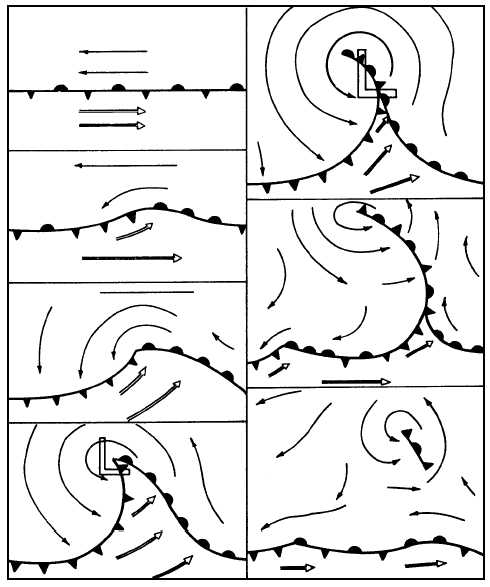Unstable Waves
The unstable wave is by far the more common wave
that is experienced with development along the polar
front. The amplitude of this wave increases with time
until the occlusion process occurs. The formation of a
deep cyclone and an occluded front breaks up the polar
front. When the occlusion process is complete, the
polar front is reestablished. This process is shown in
figure 4-22. Views A through G of figure 4-22, referred
to in the next three paragraphs, show the life cycle of
the unstable wave.
In its initial stage of development, the polar front
separates the polar easterlies from the mid-latitude
westerlies (view A); the small disturbance caused by
the steady state of the wind is often not obvious on the
weather map. Uneven local heating, irregular terrain, or
wind shear between the opposing air currents may start
a wavelike perturbation on the front (view B); if this
tendency persists and the wave increases in amplitude,
a counterclockwise (cyclonic) circulation is set up. One
section of the front begins to move as a warm front
while the adjacent sections begin to move as a cold
front (view C). This deformation is called a frontal
wave.
The pressure at the peak of the frontal wave falls,
and a low-pressure center is formed. The cyclonic
circulation becomes stronger; the wind components are
now strong enough to move the fronts; the westerlies
turn to southwest winds and push the eastern part of the
front northward as a warm front; and the easterlies on
the western side turn to northerly winds and push the
western part southward as a cold front. The cold front is
moving faster than the warm front (view D). When the
4-23
COLD
WARM
COLD
WARM
COLD
FRONTAL
WAVE
WARM
COOL
COLD
WARM
WARM
COLD
WARM
COLD
COOL
WARM
COLD
COOL
A
B
C
D
E
F
G
AG5f0422
Figure 4-22.—Life cycle of an unstable frontal wave.


